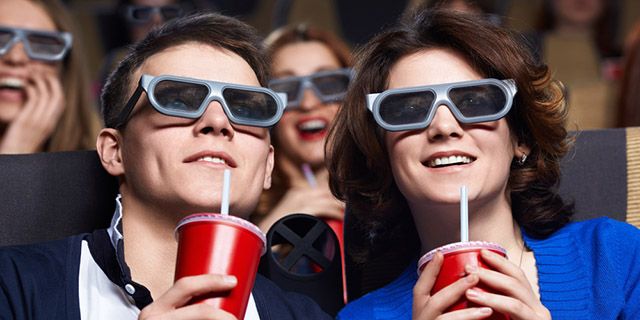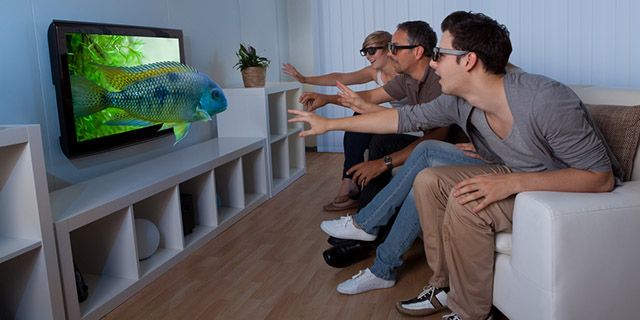The smart TV still has potential to revolutionize home entertainment. If you're unfamiliar with smart TVs, now may be the time for you to catch up and see what you've been missing. Now with Smart TV 3D technology, you have even more options to consider.
Long story short, Smart TVs are TVs with built-in Internet capabilities that allow you wider access to media than a traditional TV. But before you go out and buy one to add to your smart home collection, there's one particular smart TV feature for which you need to ask yourself, "Do I really need this?"
That feature is 3D content, which is something that people either love or hate. There's rarely any middle ground.
So let's take a look at 3D smart TVs to see if they're worth the price markup. The results may surprise you.
Everyone Loves 3D Entertainment
Here's the thing about modern entertainment: up until recently, all films and TV shows were projected in 2D even though we see in 3D. While 2D is certainly easier to capture and produce, the downside is that we lose an important element in the process: depth perception.
Stereoscopic 3D isn't new technology by any stretch. There are recorded patents from the 1890s that illustrate attempts at 3D imagery using side-by-side projections and a physical device used to converge the two into one. Sounds similar to 3D glasses, doesn't it?
But 3D didn't surge back into popularity until the 21st Century, hitting a climax with films like Avatar (2009), Gravity (2013), and Guardians of the Galaxy (2014). It's around that same time - late 2000s, early 2010s - that smart TVs first hit the market with Samsung leading the charge.
And it wasn't long after that before smart TVs began incorporating 3D display technology. My own smart TV, which is a few years old at this point, came with a two-pack of 3D glasses to watch 3D films and TV shows.
But what good is it? Can 3D entertainment at home replicate the experience of 3D in a theater? How many people even use the feature?
3D Smart TVs: Hyped & Hopeful
The biggest source of hype for 3D content came around the time of Avatar, a film that successfully transported audiences to a fantasy world lush enough to seem alive and real even on a traditional 2D screen - but with 3D glasses, it was a brand new experience altogether.
Recapturing that feeling is what 3D smart TVs were meant to do. How much more immersive would the experience be if you could lounge back on your couch, toss on a pair of freely-included 3D glasses, and watch as figures and forms reached out at you through the screen as opposed to the flat nature of traditional TV? In theory, it sounds great.
But it's about more than just that.
For one, there were promises made about the future availability of 3D broadcast channels in countries around the world. In 2010, South Korea began broadcasting a SKY 3D channel, while ESPN branched out into ESPN 3D, which provided 3D coverage of live sports. Other networks began dabbling in 3D video-on-demand around the same time.
And then there was the possibility of real-time conversion from 2D to 3D. Only high-end models came with this feature, but the concept was great in theory: the TV itself would alter an incoming 2D broadcast and output a modified version that would appear 3D when wearing the glasses. That way even non-3D channels would benefit from the technology.
All of this seems quite promising, doesn't it? Which is why 3D smart TV sales climbed throughout 2010 (2.26 million units), 2011 (24.14 million units), and 2012 (41.45 million units). If that isn't rapid growth, I don't know what is!
The Reality of 3D Smart TVs
Unfortunately, 3D smart TVs fell short in nearly every single area where big promises were made.
First of all, the real-time conversion feature between 2D and 3D never proved to be as good as it was hyped to be. At best it produces pictures that are somewhat watchable, which is fine for things like live sport feeds, but even then it isn't much better than watching in straight 2D. But at its worst, 2D-to-3D conversion is a big headache.
So until there's a big breakthrough, 3D smart TVs suffer from a massive issue: a lack of relevant 3D content.
Many of the 3D-specialized broadcast channels have shut off their signals. In 2013, the BBC ended all manner of 3D programming due to low adoption numbers. In the same year, ESPN, DirecTV, and Xfinity all ended their respective 3D channels. No surprise when only 115,000 Americans were tuned into a 3D channel at any given time in 2012.
This means that the only way to get good 3D entertainment is to buy films and shows that are specifically produced with 3D in mind. The problem? 3D is expensive to produce, so it's often saved for high-action titles that have big budgets to work with, resulting in a dearth of content availability.
And then there's the issue of smart TV security risks, which is a problem that isn't directly related to 3D viewing but relevant all the same. Buying a 3D smart TV means you need to be wary of hackers, malware, and spies (peeping through your smart TV camera).
Lastly, you have to wear those silly glasses if you want to watch in 3D. Some may be fine with that, but others - like myself - find those glasses to be both ridiculous and uncomfortable.
Worth It? The Answer Is "No"
Some have gone on record with claims that 3D TV is making a comeback, but I disagree. I think the peak is way behind us and the idea will die within just a few more years. In its current state, the technology just isn't good enough to warrant the price or hype.
I've had my 3D smart TV for over three years now. The day I opened the box is the only day I've ever worn those silly 3D glasses, and not a day has gone by where I've felt like I've missed out.
Do you have a 3D smart TV? If so, how often do you watch 3D content? Is the 3D fad still in its infancy or is it well past its prime? Share your thoughts with us in the comments below!
Image Credits: Stream of 3D Via Shutterstock, Couple Watching 3D Film Via Shutterstock, Smart TV & Remote Via Shutterstock, Group Watching 3D TV Via Shutterstock, 3D Glasses Girl Via Shutterstock





